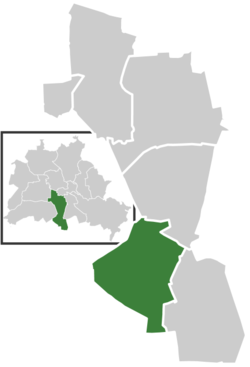Marienfelde
Marienfelde | |
|---|---|
 Kiepertplatz | |
| Country | Germany |
| State | Berlin |
| City | Berlin |
| Borough | Tempelhof-Schöneberg |
| Founded | 1220 |
| Area | |
| • Total | 9.15 km2 (3.53 sq mi) |
| Elevation | 40 m (130 ft) |
| Population (2008-06-30) | |
| • Total | 30,151 |
| • Density | 3,300/km2 (8,500/sq mi) |
| Time zone | UTC+01:00 (CET) |
| • Summer (DST) | UTC+02:00 (CEST) |
| Postal codes | (nr. 0705) 12277, 12279 |
| Vehicle registration | B |
Marienfelde is a locality in southwest Berlin. It is a mixed industrial and residential area, and part of the borough of Tempelhof-Schöneberg.
Transportation and industry
Transportation and industry have played an important role in the development of Marienfelde.
The Prussian military railway, the Königlich Preußische Militäreisenbahn, passed through the Marienfelde area on its way from Berlin to the town of Zossen. Between 1901 and 1904, the track was electrified and used as test track for high-speed locomotive testing. Ten kilovolt, three-phase alternating current with a frequency of 50 hertz was transmitted over three overhead wires, strung one above the other. Experimental electrical locomotives reached speeds of up to 210.8 km/h (131 mph) on the track.
Near the end of World War II, as part of the Elbe-Project, the world's first high-voltage direct current transmission lines were built from a power plant in Dessau, on the Elbe river, to Marienfelde. A substation was located in Marienfelde converted the direct current into alternating current. However, developments in the war prevented the project from ever becoming operational.
Today, Marienfelde is the location of a number of important industries, including a Daimler AG assembly plant. The main North-South rail line entering Berlin also passes through Marienfelde.
Refugee processing center
Marienfelde is also known for a large refugee processing center which operated during the cold war. The center, which opened in 1953, was the first stop for more than 1.5 million refugees fleeing communism in East Germany via West Berlin. Refugees arriving in West Berlin were sent to the center where they received medical treatment, food, identification papers, and housing until they could be permanently re-settled in the West.
Even after the fall of the Berlin Wall in 1989, the center continued processing East German refugees until unification a year later. Today the center remains in use, processing ethnic Germans who are immigrating to Germany from the former Soviet Union.
External links
![]() Media related to Marienfelde at Wikimedia Commons
Media related to Marienfelde at Wikimedia Commons

